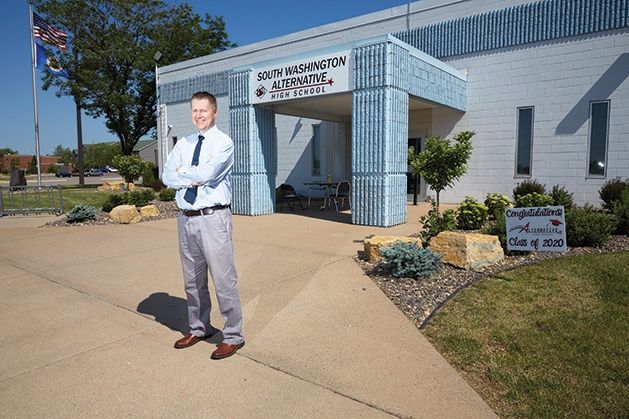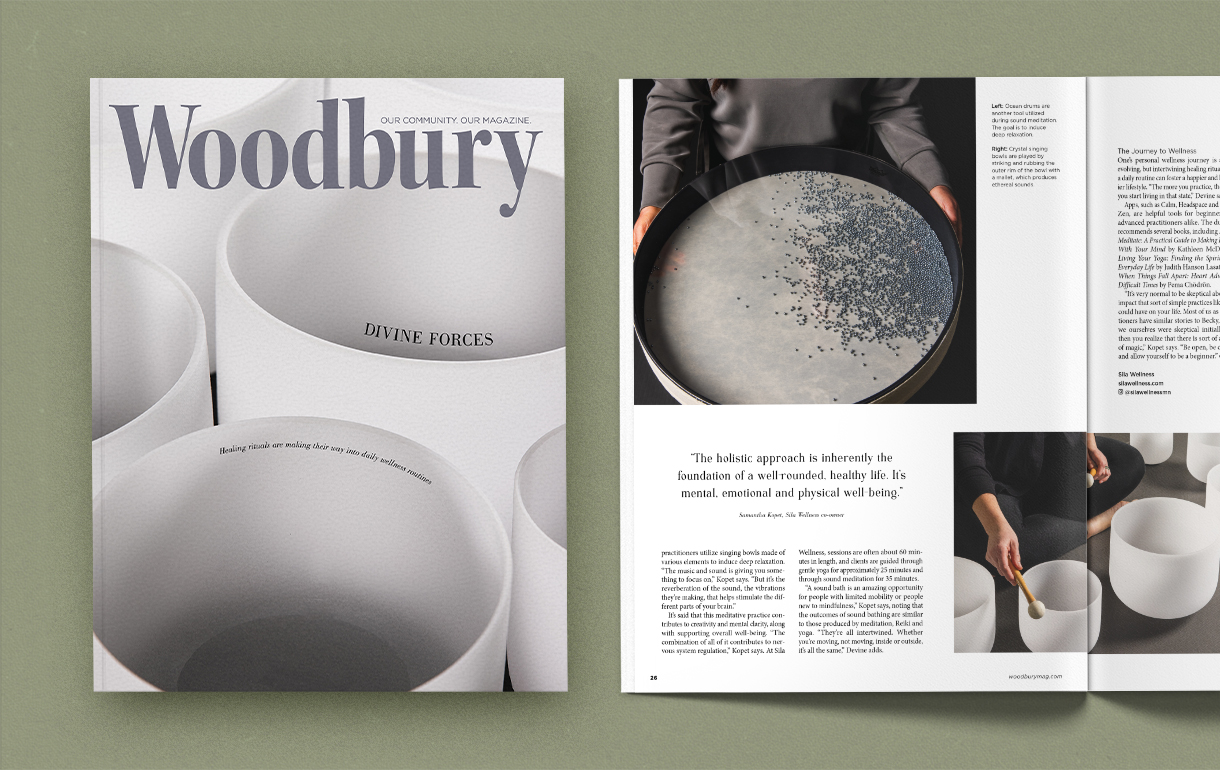
Principal Nicolas Falde joined South Washington Alternative in 2018. PHOTO BY: TATE CARLSON
South Washington Alternative High School offers auxiliary learning.
“Our biggest goal is to try to build relationships with students,” says South Washington Alternative High School’s (SWAHS) principal Nicolas Falde. “We try to do that first, before we dive heavily into the academic piece, because something along the line probably didn’t work for the students who are coming to us.”
That relationship-building often starts with the student advisor, who stays with the student for the entire time they’re at SWAHS. “We have an advisory hour each day to help students build that connection,” says Falde. “The advisors are in daily contact with their student to make sure they have the resources they need and to check if they need any support.”
The advisory hour is also often used for planning, as advanced via individual determination (AVID) coordinator Anne Piasecki explains: “The area in advisory that we’ve really focused on is the college career readiness path—knowing about it, but also helping kids to define their futures a bit more. One big thing we believe in our building is that success can look a lot of different ways; whether that is certification in something post-high school, whether that is a two-year program or a technical program.”
SWAHS is one of only a handful of alternative programs that are AVID certified in the state of Minnesota. But even though the AVID course itself is elective, the teaching methodology underpins class instruction across the board. “We try to put AVID into our entire day because we feel all of our students can benefit from the teaching strategy that AVID brings,” explains Piasecki.
Most of these skills are structural, with an emphasis on future planning. “We do a lot of time management, a lot of goal setting,” says Piasecki. “[Also] a lot of learning how to ask the right questions and dig a little bit deeper.”
Often students know what they want to do, but might not know how. Not only does knowing how to ask for help make a difference, but knowing there are resources available to you takes a lot of anxiety out of the process.
“We have a connection with a financial aid worker who comes in and will help our kids,” says Piasecki. The students are brought to tour campuses and taken through the steps to sign up for placement tests. “We try to get rid of as many barriers as possible and be that real support that many of them need,” Piasecki says.
Another strength of the AVID program, as Piasecki sees it, is the overall staff buy in to the methodologies. “Everybody’s using the same language across the board,” she explains. “So when we say, ‘levels of questioning,’ the kids know what we’re talking about. When we’re talking about graphic organizers and organizational skills and smart goals, they’re all on board.”
“What I’ve really begun to notice is the carryover between class to class is strengthening,” Piasecki adds. “I’m also really beginning to see a lot of students begin to go, ‘I can do this. This isn’t scary, or it’s not as scary as I thought it was going to be.’”
It helps that advisors and faculty are on hand to help students through these daunting processes, whether it’s applying for financial aid or finding information about post-high school programs.
This individualized attention is aided by the comparatively small size of the student population. “You know, when you have a small class you can’t really hide,” says Piasecki. “A lot of our students, that’s been their mechanism for getting through before. They didn’t really complain; they could kind of hide and get by.”
With about 120 students total, class sizes at SWAHS can fluctuate but usually they stay below 15 students. Nobody’s lost in the background because there isn’t one.
Rising senior and student council member Jessie McGriff says one of the things she likes about SWAHS is its size. “[The school] is very small, and you don’t experience as much anxiety as you would with regular high schools.”
A smaller student body also means the students, who are usually coming in from the neighboring schools of Woodbury and East Ridge High Schools, and Cottage Grove’s Park High School, get a chance to know each other better.
“The best thing definitely is how you know everyone, and you’re friends with everyone,” says McGriff. “There is no judgement at this school because there are no cliques, you simply can just be yourself.”
McGriff says people would probably be surprised to learn how much one-on-one time the faculty is able to give students at SWAHS. “[The teachers] are very supportive and meet your needs and adapt to your learning skills and how you need to be taught,” she says.
As it turns out, the process of adapting to students’ personal learning styles at SWAHS starts before the students so much as step through the front door. “We have an orientation process students go through coming in, but we also have an application process,” principal Falde says. “All students complete an application so we can have a better understanding of who they are as a person and what resources we’re going to need to support them.”
Looking to the upcoming school year, it’s inevitable changes will have to be made to education programs district-wide in light of the COVID-19 pandemic. “A lot of times we would try to have community building-type activities within our school,” says Falde. “And we’re still going to try to do those as much as possible. It’s just rethinking as a staff how we do those that keeps everyone safe.”
“We want students to be successful, we want students to have a path, once they leave us, to whatever their next step is, and we want that to be a positive experience,” says Falde. “What it comes down to now is still that, but also keeping everyone safe.”






















